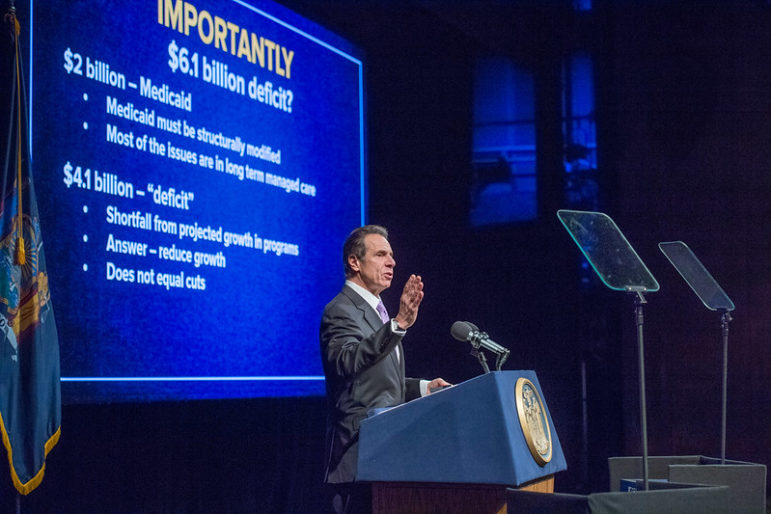
Darren McGee- Office of Governor Andrew M. Cuomo)
Gov. Cuomo presents his fiscal year 2021 Executive Budget in Albany.In mid January, the de Blasio administration released its 2021 preliminary budget. A week later the Cuomo administration released its proposed 2021 budget. Both budgets had to contend with a projected $6.1 billion projected shortfall linked to Medicaid and driven in large part by Managed Long Term care, a result of the city and state’s graying population.
Neither administration used its budget to try to provide solutions to the ballooning number of seniors in the Medicaid system, whose numbers will only grow. The Cuomo administration introduced a plan to essentially shift financial responsibility for that growth onto localities, setting up a 3 percent growth-rate cap that many counties with new enrollees would have trouble obeying. Both budgets will likely set up months of pushback from advocates for the aging before being finalized.
Advocates have long been ringing the alarm about how the aging crisis would eventually hit New York economically, and potentially at higher cost if lawmakers don’t support long-term care and other senior services. When it was learned that a third of the state’s $6.1 budget gap was attributable to Medicaid, many were left wondering how the Cuomo administration would rein in spending.
The governor provided few solid details, but announced that he would reconvene a 2011 panel called the Medicaid Redesign Team, an advisory group of experts who made sweeping changes to dozens of Medicaid programs nearly a decade ago in an effort to cut costs. The MRT will be tasked with finding $2.5 billion of savings in the Medicaid budget.
The $2.1 billion gap attributed to Medicaid is a gap between spending and a self-imposed (but legally binding) growth rate cap, which was created when the first Medicaid Redesign Team convened in 2011. The cap, which is tied to the consumer price index, has been criticized for being designed only to accommodate inflation but not ballooning enrollment in Medicaid.
And enrollment has been booming over the last decade, the result of new enrollees thanks to the Affordable Care Act (a.k.a. Obamacare) and an aging population, who rely on Medicaid for long-term care.
City leads Managed Long Term Care boom
Under the restructuring made by the original Medicaid Redesign Team, Medicaid enrollees who are also eligible for Medicare, or the “dual eligible,” are required to sign up for a Managed Long Term Care Plan for their home care needs. Managed Long Term Care plans, or MLTC’s, are privately-run state funded insurance plans. There were 256,000 people enrolled in these MLTC plans as of December 2019, compared to 71,000 in December 2012, the first year those original MRT reforms went into effect.
While MLTC enrollees account for only 4 percent of the state’s 5.8 million Medicaid recipients, they represent 68 percent of all the state’s Medicaid spending. The reason is the higher cost of caring for the elderly and disabled: New York state spent $7,806 per Medicaid enrollee on average, but spent an average of $20,888 for every aged recipient, and on average over $24,000 for disabled recipients, according to an analysis of 2014 data by the Empire Center.
Those costs mainly come from the downstate region; 94 percent of MLTC enrollees are clustered in NYC, Nassau and Suffolk, and Westchester. New York City accounts for 76 percent of all MLTC enrollment.
The recent executive budget briefing from the governor notes that the rate cap created by the first MRT doesn’t factor in growth in enrollment, saying, “this metric exclusively reflects an increase in unit prices, but does not account for changes in utilization of services or Medicaid program enrollment.”
Since the Medicaid budget shortfall became public, there has been talk from some in the health care field of adjusting or ending the self-imposed cap. Speaking to City Limits before the governor’s budget was presented, Helen Schaub, New York State policy director of 1199SEIU, said, “the global cap is a budgeting tool, so we should have a conversation about whether the cap is at the right level.” Schaub said that the growth in enrollment, a higher minimum wage, and higher pay for home-care workers are all positive developments despite being factors that increased Medicaid costs.
The 2011 Medicaid Redesign Team that Cuomo wishes to reconvene has a mixed legacy. The growth of Medicaid in NY indeed slowed, from a projected 13 percent growth rate in 2010 to an average 2.2 percent from 2013-2018. Per recipient spending went down by $1,200 between 2011 and 2016.
But critics have pointed out that the reduced growth rate was sometimes achieved by shifting funding toward unskilled, informal peer labor. In some cases, the MRT led to partial privatization that critics say created a perverse incentive in some programs and inhibited quality of care.
Cost-saver’s popularity boosts its pricetag
The governor’s most recent budget briefing signals concern about paying informal family members through CDPA, or the consumer-directed personal assistant program.
That program allows a person receiving care to hire out informal caregivers, including family members. The program was originally designed for disabled persons of all ages, who advocated for more autonomy and independent living. As a result of the original MRT, CDPA was promoted to seniors on Medicaid as a cheaper alternative to nursing homes. It is “designed to divert members from high-cost nursing homes and institutional settings to less costly in-home care that keeps them in their communities,” according to the Cuomo administration.
CDPA enrollment grew 88 percent from 2014 to 2019, and by 85 percent from 2017 to 2018 alone, when spending on the program reached $2.5 billion a year. According to the Cuomo administration, CDPA and the Managed Long-Term Care plans generally are “the biggest drivers of spending growth in New York’s Medicaid program.”
The proposed budget does not explicitly call for changes to CDPA, leaving that for the newest Medicaid Redesign Team to figure out before April.
In a statement on behalf of CDPAANYS, a lobbying group for fiscal intermediaries that do payroll and provide guidance to CDPA consumers, the group’s executive director Bryan O’Malley said, “CDPA has provided many New Yorkers with a higher quality of service at a lower cost than nursing homes and helped many continue to live independently. It has been immensely popular as it is smart policy, particularly because home care healthcare staffing shortages continue to deepen.”
The group provided City Limits with recommendations that it says would keep CDPA intact, including less frequent assessments, eliminating fraud and double-billing, and dis-enrolling people no longer eligible. O’Malley also said the next Medicaid Redesign Team should be comprised of seniors and people with disabilities.
The governor’s budget does propose cutting tax credits for people receiving long-term care. Currently, up to 20 percent of long-term care costs are covered by tax credits regardless of income level. The budget proposes capping that at $1,500 per person and restricts credits to people making under $250,000.
Broader budget criticisms
The potential cuts to caregiver support contrast with what advocates have recommended. In a recent set of recommendations, The Center for An Urban Future proposed instead boosting support for caregivers, including informal family caregivers. The think tank recommends a tax credit for family caregivers, similar in scope to a U.S. Senate bill that would provide $3000 a year to caregivers.
CUF, whose report is focused on improving care and program efficiency and not addressing the budget gap, also recommends tripling funding for EISEP, Expanded In-Home Services for the Elderly Program, a free or low-cost home health aide program that the state provides for earners that make too much to qualify for Medicaid.
And CUF suggests expanding the social safety net to cover seniors who don’t qualify for Medicaid – on which seniors rely for long-term care – by creating a new pot of funding for seniors at 200 percent of the poverty line. A state-run health expansion of this type is unlikely to happen under the Cuomo administration.
On other aging issues, the advocacy group LiveOn NY found the governor’s budget to be mixed.
In a statement, Katelyn Andrews praised $798,000 of increased funding for the wellness-in-nutrition program, which provides home-delivered meals to elders. The administration also proposed increased funds for affordable senior housing and $15 million for other unmet needs across the state.
But LiveOn admonished the governor’s failure to make added cost-of-living adjustments for workers contracted by the state Office For the Aging, saying, “By disregarding these needed wage increases, the state continues to put the human services workforce at financial risk as they age.” They also estimated that funds for older New Yorkers decreased by 0.8 percent overall in the budget, despite the aging of the population.
The governor’s 2020 Medicaid Redesign Team, MRT II, has to report back before the April 1 budget deadline. The group will be co-chaired by Northwell Health CEO Michael Dowling and 119SEIU labor leader Dennis Rivera, but no other appointments have been announced. The governor must agree to a budget with the state legislature before the state’s fiscal year begins on April 1.
Mayor’s budget slows growth of senior spending
The mayor’s executive budget was designed with the state Medicaid shortfall in mind. Although the city’s budget was released on January 16, days before the governor’s January 21 presentation, its relative austerity – the budget grew only 2.7 percent from last year’s budget – was shaped by a fear that the state would attempt to shift costs to localities. “We’ve never seen this kind of threat from the state budget,” Mayor De Blasio said at his budget press conference.
Those fears were borne out when the governor released his budget proposal and its proposed 3 percent Medicaid growth cap for localities, as it is unlikely the city can keep spending under 3 percent with an aging population and growing enrollment in MLTC’s.
Meanwhile, NYC’s spending on its Department for the Aging would increase under De Blasio’s plan, it would be an incremental one and not in line with the infusion of funds advocates are asking for.
DFTA is funded by the city, state and federal government, although the city’s contribution makes up most of the budget. That share has also been going up, from 63 percent in 2017 to 69 percent in 2019 according to a City Limits analysis of OMB data. While the total “actual” budget in 2019 – what the agency ended up spending – reached $388 million, the mayor’s 2021 plan projects spending at around $385 million. While that number will likely go up by millions when more items are negotiated into the final budget, it would still likely be less than the $30 million year-over-year increases the DFTA budget saw between 2017 and 2019.
This is significant because the senior population is growing quickly: The number of New Yorkers over 65 grew 19 percent from 2005 to 2015, and is projected to increase from about 1.1 million today to 1.4 million in 2030.
The New York City Council and mayor must agree to a budget before the next fiscal year on July 1.









